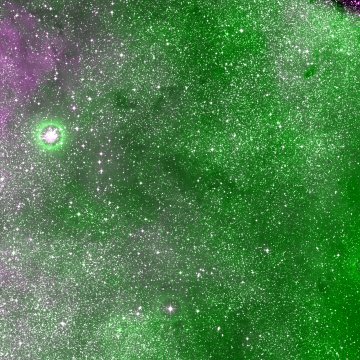Gum 67
Also called
RCW 132, Sh 2-12Coordinates: (355.4°, 0.2°)
[ Catalog | Explorer | SIMBAD ]
A 2008 paper by Piskunov, Schilbach, and Kharchenko et. al. finds that NGC 6383 has about 400 solar masses and Trumpler 27 has about 1600 solar masses.[2] Although both clusters appear to lie at about the same distance, it is the less massive cluster that ionises the nebula, presumably because HD 159176 lies within a large cloud of molecular hydrogen but the area around Trumpler 27 is clear of such gas.
The clusters and field stars in this region (which include several Wolf-Rayet stars) are visible in this false-colour hydrogen-alpha image from the Milky Way Explorer.
A more detailed black-and-white SuperCOSMOS hydrogen-alpha image is available here.
Bica et.al. report an infrared star group, [BDS2003] 102, within the nebula. [3]
Curiously, a 2000 paper by Dutch and US astronomers, which is otherwise very thorough, claims that NGC 6383 is a member of the Sgr OB1 association. In fact Sgr OB1 is located several degrees away on the opposite side of the galactic centre. [4]
Notes
1. ^ Kharchenko, N. V., Piskunov, A. E., Röser, S., et al. (2005). "Astrophysical parameters of Galactic open clusters", Astronomy and Astrophysics, Vol. 438, 1163-1173. [2005A&A...438.1163K]
2. ^ Piskunov, A. E., Schilbach, E., Kharchenko, N. V., et al. (2008). "Tidal radii and masses of open clusters", Astronomy and Astrophysics, Vol. 477, 165-172. [2008A&A...477..165P]
3. ^ Bica, E., Dutra, C. M., Soares, J., et al. (2003). "New infrared star clusters in the Northern and Equatorial Milky Way with 2MASS", Astronomy and Astrophysics, Vol. 404, 223-232. [2003A&A...404..223B]
4. ^ van den Ancker, M. E., Thé, P. S., & de Winter, D. (2000). "The central part of the young open cluster NGC 6383", Astronomy and Astrophysics, Vol. 362, 580-584. [2000A&A...362..580V]
Distance estimates
985 pc [2002A&A...389..871D]1730 pc [2007A&A...462..157P]
985 pc [2005A&A...438.1163K]
1300 pc +/- 100 [2010A&A...511A..25R]
1400 pc +/- 300 [1989BAICz..40...42A]
1400 pc [2003A&A...404..223B]
Links
[ DSS | ADS | ADS Abstract ]
map | book | blog | gallery | sources

This image was created using the POSS-II/UKSTU data of the Digitized Sky Survey and SuperCOSMOS using the process described here.
According to my correspondence with the Royal Observatory Edinburgh and the Space Telescope Science Institute, I am allowed to use the POSS-II/UKSTU data to create and display images for non-commercial purposes so long as I include this fine print for the SuperCOSMOS data:
Use of these images is courtesy of the UK Schmidt Telescope (copyright in which is owned by the Particle Physics and Astronomy Research Council of the UK and the Anglo-Australian Telescope Board) and the Southern Sky Survey as created by the SuperCOSMOS measuring machine and are reproduced here with permission from the Royal Observatory Edinburgh.
and this acknowledgement taken from the DSS site:
The Digitized Sky Surveys were produced at the Space Telescope Science Institute under U.S. Government grant NAG W-2166. The images of these surveys are based on photographic data obtained using the Oschin Schmidt Telescope on Palomar Mountain and the UK Schmidt Telescope. The plates were processed into the present compressed digital form with the permission of these institutions.
The Second Palomar Observatory Sky Survey (POSS-II) was made by the California Institute of Technology with funds from the National Science Foundation, the National Geographic Society, the Sloan Foundation, the Samuel Oschin Foundation, and the Eastman Kodak Corporation.
The UK Schmidt Telescope was operated by the Royal Observatory Edinburgh, with funding from the UK Science and Engineering Research Council (later the UK Particle Physics and Astronomy Research Council), until 1988 June, and thereafter by the Anglo-Australian Observatory. The blue plates of the southern Sky Atlas and its Equatorial Extension (together known as the SERC-J), as well as the Equatorial Red (ER), and the Second Epoch [red] Survey (SES) were all taken with the UK Schmidt.
The "Second Epoch Survey" of the southern sky was made by the Anglo-Australian Observatory (AAO) with the UK Schmidt Telescope. Plates from this survey have been digitized and compressed by the ST ScI. The digitized images are copyright ? 1993-5 by the Anglo-Australian Observatory Board, and are distributed herein by agreement.
The "Equatorial Red Atlas" of the southern sky was made with the UK Schmidt Telescope. Plates from this survey have been digitized and compressed by the ST ScI. The digitized images are copyright ? 1992-5, jointly by the UK SERC/PPARC (Particle Physics and Astronomy Research Council, formerly Science and Engineering Research Council) and the Anglo-Australian Telescope Board, and are distributed herein by agreement.
The compressed files of the "Palomar Observatory - Space Telescope Science Institute Digital Sky Survey" of the northern sky, based on scans of the Second Palomar Sky Survey are copyright ? 1993-1995 by the California Institute of Technology and are distributed herein by agreement. The compressed files of the "Palomar Observatory - Space Telescope Science Institute Digital Sky Survey" of the northern sky, based on scans of the Second Palomar Sky Survey are copyright ? 1993-1995 by the California Institute of Technology and are distributed herein by agreement.